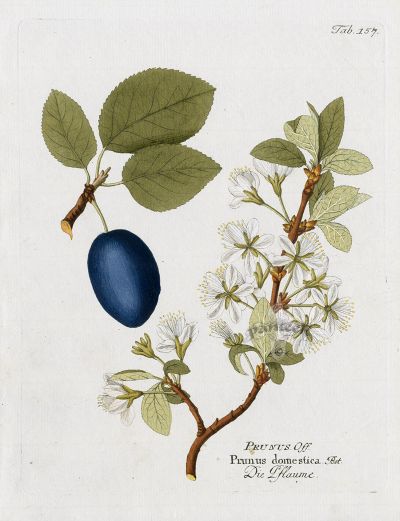European Plum
European Plum
Prunus domestica L.
Family Rosaceae
Description of Plum
European plum is a deciduous tree or shrub, 2–6 m tall, with gray-brown bark and a spreading crown. Leaves are alternate, oval, 4–10 cm, dark green, with a serrated edge. Flowers are white or pinkish, 1–2 cm, solitary or in small groups (2–5 flowers). Fruits are drupes, 2–6 cm, purple, blue, red, or yellow, with juicy pulp and a single pit. Varieties: 'Italian Prune', 'Stanley', 'Reine Claude (Greengage)', 'Mirabelle', 'Damson'. Flowering in April–May, fruiting in July–September.
Habitat and Ecology of Plum
The origin of plum is the Caucasus, Asia Minor, and the Mediterranean. It grows in temperate zones of Europe, Asia, North America, on plains and in foothills, up to 1000 m above sea level. It is cultivated in Russia, Ukraine, Moldova, USA. It prefers loamy or sandy loam soils (pH 6.0–7.5), sunny areas, watering 20–30 l/tree once every 10–14 days. Propagated by cuttings, grafting, pits. Yield: 20–50 kg/tree. Care: pruning, potassium fertilization (15–20 g/m²), protection from aphids, codling moths. Used in landscaping, for hedges, as a honey plant.
Plum Raw Material
Raw material: fruits (fructus Pruni domesticae), leaves (folia Pruni domesticae), pits (semina Pruni domesticae). Fruits are harvested in July–September, dried at 40–50 °C (yield 15–20%). Leaves are harvested in June–July, dried at 40 °C (yield 15–20%). Pits are dried at 30–40 °C (yield 20–25%). Quality: fruits — no mold, purple or yellow; leaves — green; pits — brown; moisture ≤12%. Store in airtight containers (fruits: 1 year; leaves: 1 year; pits: 2 years). Scent is sweet (fruits), neutral (leaves, pits), taste is sweet and sour (fruits).
Chemical Composition of Plum
Fruits: water (87%), sugars (up to 12%), organic acids (malic, citric, up to 1.5%), pectins (up to 2%), vitamin C (up to 20 mg%), A, E, K, flavonoids, anthocyanins, minerals (K, Mg, Fe). Leaves: tannins (up to 3%), flavonoids, vitamin C (up to 30 mg%). Pits: amygdalin, fatty oils (up to 40%). Calorie content of fruits: 40–50 kcal/100 g (fresh), 200–250 kcal/100 g (dried).
Action and Application of Plum
Plum has laxative, diuretic, antioxidant, anti-inflammatory, and general tonic effects. It is used for constipation, hypertension, anemia, colds, edema, and skin inflammations. Fruits improve digestion, strengthen blood vessels, and lower cholesterol. Leaves help with sore throats and dermatitis. Pits (oil) are used to moisturize the skin. Fruit juice increases appetite and supports kidney health.
Precautions for Plum Use
Consumption of >500 g/day of fresh or >100 g/day of dried fruits can cause diarrhea, bloating. Store juice at 0–5 °C for no longer than 24 hours. Children under 3 years old should be given ≤50 g/day of fruits. Pits contain amygdalin (possible toxicity with excessive consumption). Long-term use of leaf infusions (>2 weeks) requires medical supervision. Wash fruits thoroughly due to pesticides.
Contraindications for Plum Use
Allergy to Rosaceae, gastritis with high acidity, exacerbated stomach ulcers, diarrhea, diabetes mellitus (for dried fruits), pregnancy, lactation.
Plum Recipes
- Fruit decoction for constipation. Boil 30 g of dried fruits in 200 ml of water for 15 minutes, drink 50 ml twice a day for 5 days.
- Leaf infusion for sore throat. Pour 200 ml of boiling water over 10 g of leaves, infuse for 20 minutes, gargle twice a day for 5 days.
- Juice for anemia. Drink 50 ml of fruit juice twice a day for 7 days.
- Compresses for dermatitis. Pour 100 ml of boiling water over 10 g of leaves, infuse for 20 minutes, apply for 15 minutes, twice a day for 7 days.
- Plum Jam with Spices. Cook plums with sugar, cinnamon, and cloves until thickened. Great for toast or as a topping for desserts.
- Roasted Pork with Plums. Roast pork loin with fresh plums, onions, and rosemary for a savory and sweet main course.
Plum Cosmetics
Plum is used for skin care.
- Mask for rejuvenation. 20 g of fruit pulp, 10 ml of honey, apply for 15 minutes, rinse, twice a week.
- Lotion for hydration. 20 ml of fruit juice, 10 ml of water, wipe the skin, once a day.
- Mask for oily skin. 20 g of pulp, 10 ml of yogurt, apply for 20 minutes, rinse, twice a week.
- Pit scrub. 10 g of ground pits, 10 ml of olive oil, massage into skin for 5 minutes, rinse, once a week.
- Plum and Oatmeal Exfoliator. Mix mashed plums with fine oatmeal and a little water to create a gentle exfoliating scrub.
Plum Cuisine
Fruits are used fresh, dried, in desserts, and drinks.
- Compote. 200 g fresh fruits, 1 L water, 50 g sugar, boil for 15 minutes.
- Jam. 1 kg fruits, 800 g sugar, 200 ml water, cook for 30 minutes, store in jars.
- Sauce for meat. 200 g fruits, 50 g sugar, 10 ml vinegar, cook for 20 minutes.
- Smoothie. 200 g pulp, 100 ml yogurt, 10 g honey, blend.
- Plum Crumble. Top sliced plums with a mixture of flour, sugar, butter, and oats, then bake until golden and bubbly. Serve with ice cream.
- Prune-Stuffed Pork Loin. Make an incision in a pork loin, stuff with softened prunes, and roast.
Tips: Store fresh fruits at 0–5 °C for up to 1 month, dried (prunes) — for up to 1 year. Remove pits before cooking.
Other properties of plum
Used in ornamental landscaping, for hedges, as a honey plant.




